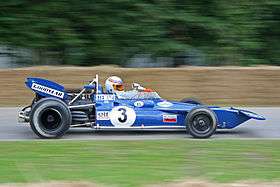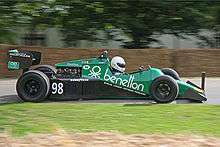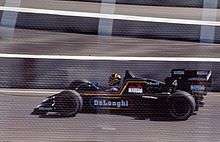Tyrrell Racing
 | |
| Full name | Tyrrell Racing Organisation |
|---|---|
| Base | Ockham, Surrey, United Kingdom |
| Founder(s) | Ken Tyrrell |
| Noted staff |
Derek Gardner Mike Gascoyne Tim Densham Harvey Postlethwaite |
| Noted drivers |
|
| Next name | British American Racing |
| Formula One World Championship career | |
| First entry | 1968 South African Grand Prix |
| Races entered |
As a constructor: 432 entries (430 starts) As a team: 465 entries, 463 starts. |
| Constructors |
Matra March Tyrrell |
| Constructors' Championships | 1 (1971) |
| Drivers' Championships | 3 (1969, 1971, 1973) |
| Race victories | 33 |
| Pole positions | 19 |
| Fastest laps | 27 |
| Final entry | 1998 Japanese Grand Prix |
| Formula One World Championship career | |
|---|---|
| Entrants |
Tyrrell Racing, several minor teams and privateers |
| First entry | 1970 Canadian Grand Prix |
| Last entry | 1998 Japanese Grand Prix |
| Races entered | 432 entries (430 starts) |
| Race victories | 23 |
| Constructors' Championships | 1 (1971) |
| Drivers' Championships | 2 (1971, 1973) |
| Pole positions | 14 |
| Fastest laps | 20 |
The Tyrrell Racing Organisation was an auto racing team and Formula One constructor founded by Ken Tyrrell which started racing in 1958 and started building its own cars in 1970. The team experienced its greatest success in the early 1970s, when it won three Drivers' Championships and one Constructors' Championship with Jackie Stewart. The team never reached such heights again, although it continued to win races through the 1970s and into the early 1980s, taking the final win for the Ford Cosworth DFV engine at Detroit in 1983. The team was bought by British American Tobacco in 1997 and completed its final season as Tyrrell in 1998.
Lower formulae (1958–1967)
Tyrrell Racing first came into being in 1958, running Formula Three cars for Ken Tyrrell and local stars. Realizing he was not racing driver material, Ken Tyrrell stood down as a driver in 1959, and began to run a Formula Junior operation using the woodshed owned by his family business, Tyrrell Brothers, as a workshop. Throughout the 1960s, Tyrrell moved through the lower formulas, variously giving single seater debuts to John Surtees and Jacky Ickx. But the team's most famous partnership was the one forged with Jackie Stewart, who first signed up in 1963.
Tyrrell ran the BRM Formula Two operation throughout 1965, 1966 and 1967 whilst Stewart was signed to the Formula One team. Tyrrell then signed a deal to run Formula Two cars made by French company Matra.
Formula One (1968–1998)
1960s

With the help of Elf and Ford, Tyrrell then achieved his dream of moving to Formula One in 1968 as team principal for Matra International, a joint-venture established between Tyrrell's own team and the French auto manufacturer Matra. Stewart was a serious contender, winning several Grands Prix in the Tyrrell-run Matra MS10. The car's most innovative feature was the use of aviation-inspired structural fuel tanks. These allowed the chassis to be around 15 kg lighter while still being stronger than its competitors. The FIA considered the technology to be unsafe and decided to ban it for 1970, insisting on rubber bag-tanks.
For the 1969 championship, the Matra works team decided not to compete in Formula One. Matra would instead focus its efforts on Ken Tyrrell's 'Matra International' team and build a new DFV powered car with structural fuel tanks, even though it would only be eligible for a single season. Stewart won the 1969 title easily, driving the new Cosworth-powered Matra MS80 which corrected most of the weaknesses of the MS10. Stewart's title was the first won by a French chassis, and the only one won by a chassis built in France.[1] It was a spectacular achievement from a team and a constructor that had only entered Formula One the previous year.
1970s


For the 1970 season following Matra's merger with Simca, Tyrrell were asked by Matra to use their V12 rather than the Cosworth. Simca was a subsidiary of the American company Chrysler, a rival of Ford.
 |
1971 Tyrrell-Cosworth 002
|
| Problems playing this file? See media help. | |
Stewart tested the Matra V12 and found it inferior to the DFV. As a large part of the Tyrrell budget was provided by Ford, and another significant element came from French state-owned petroleum company Elf, which had an agreement with Renault that precluded supporting a Simca partner, Ken Tyrrell had little alternative but to buy a March 701 chassis as interim solution while developing his own car in secret.
Tyrrell was still sponsored by French fuel company Elf, and Tyrrell would retain the traditional French blue racing colours for most of the rest of its existence. Tyrrell and Stewart ran the March-Fords throughout 1970 with mixed success, while Derek Gardner worked on the first in-house Tyrrell Grand Prix car at the woodshed in Ockham, Surrey.
The Tyrrell 001, which bore much resemblance to the MS80, emerged at the end of 1970. It earned Stewart a pole position in the Canadian GP but suffered mechanical failures in all of its 3 race starts. The nearly identical Tyrrell 003 won both Drivers' and Constructors' Championships in 1971, with strong driving from Jackie Stewart and François Cevert. Stewart's 1972 challenge was ruined by a stomach ulcer, but he returned to full fitness in 1973. He and Cevert finishing 1st and 4th in the Championship. Tragedy struck on 6 October 1973, as Cevert was killed in practice for the US Grand Prix at Watkins Glen. Stewart, who was to retire at the end of the season, and Tyrrell immediately stood down, effectively handing the Constructor's title to Lotus. At the end of the season Stewart made public his decision to retire, a decision that was already made before the US Grand Prix. Without their star driver or his skilled French protégé aboard, Tyrrell were never serious World Championship contenders again.
Despite this, the team remained a force throughout the 1970s, winning races with Jody Scheckter and Patrick Depailler. Most notable of these was Scheckter's triumph at the 1976 Swedish Grand Prix, giving Tyrrell a 1–2 finish driving the distinctive Derek Gardner designed Tyrrell P34 car. The P34 was the first (and only) successful six-wheeler F1 car, which replaced the conventional front wheels with smaller wheels mounted in banks of two on either side of the car. The design was abandoned after Goodyear refused to develop the small tyres needed for the car as they were too busy fighting the other tyre manufacturers in Formula One.
Ken Tyrrell had been spending a lot of his own money running his team, but in the summer of 1979 he finally found a sponsor: Italian appliance manufacturing group Candy put up the money to run the 009, fielded by Jarier and Pironi.[2]
1980s

In 1977, the Turbo era dawned in Grand Prix racing, which was, by the mid-1980s, to render normally-aspirated-engined cars obsolete. Without the proper funding, Tyrrell was the last resistant with the Cosworth DFV at a time all teams had switched to turbocharged engines. It was the beginning of two decades of struggle for Tyrrell, who was often underfunded through lack of sponsorship. It seemed appropriate, then, that the final win for the classic Cosworth Ford DFV engine was taken by a Tyrrell car (the Tyrrell 011), driven by Michele Alboreto at the 1983 Detroit Grand Prix. It was also Tyrrell's last Grand Prix win.
1984 controversy
At the time, the Formula One regulations specified a minimum weight which was more than achievable with non-turbocharged cars – though not with a turbocharged car due to greater complexity – leading to some cars being built light and ballasted up to the minimum weight to optimise weight distribution. However, rules then also specified that the cars were to be weighed filled with their usual fluids. In 1982, other teams (chiefly Brabham[3] and Williams[4]) had used this provision to develop cars with features such as 'water-cooled brakes' – the car officially started the race with a large, full water tank, the water was released in the general direction of the brakes and the car ran underweight when on track and unable to be weighed, only to be later topped up sufficient water to ensure the weight limit was not breached.
As Tyrrell was the only naturally aspirated engine user in 1984 season, they were uniquely placed to be able to benefit from a similar strategy of the water brake. In Tyrrell's case, the engine was equipped with a water injection system (a common means of lowering cylinder temperatures to increase power), whose supply tank was to be topped up late in the race. In addition, the FIA had already made provision to reduce the fuel allowance for each race during the season to 220 litres and banned the refueling of 1982–83, reducing the power available to turbocharged runners while imposing little restriction on more efficient non-turbo runners. Predictably turbo-powered teams were against this move, leaving only Tyrrell – whose engine did not need the additional fuel – in favour of it. However, F1 rules required unanimity for the change to be scrapped, leaving Tyrrell in the way.

It had been observed in races that, after Tyrrell's final pit stop, lead shot could be seen escaping from the top of the car. It turned out that Tyrrell were running the car underweight during the race then, in the closing stages, topping up water injection supply tanks with an additional 2 gallons of water mixed with 140 lb of lead shot to ensure it made the weight limit. As this was pumped in under significant pressure, some escaped through the tank vent and rained down on neighbouring pits, in sufficient quantities for other teams to sweep the shot away before their drivers pitted.
After the Detroit Grand Prix where Martin Brundle had finished in second for Tyrrell, the top cars were, as usual, impounded for inspection for compliance with the rules. Following this, it was alleged that the water was in fact 27.5% aromatics and constituted an additional fuel source. Tyrrell were thus charged with:
- Taking on additional fuel during the race (then illegal)
- Use of illegal fuel (the aromatic-water mix)
- Equipping the car with illegal fuel lines (the lines from the water tank to the water injection system)
- Using ballast that was incorrectly fixed to the car (the lead shot in the water tank)
As a consequence of these charges, Tyrrell were excluded from the 1984 world championship and retroactively disqualified from all races that year. Further analysis showed that the actual fuel content of the water was significantly below 1% and well within rules.[5] Additionally, Tyrrell argued that the requirement was that the ballast had to be fixed so it required tools to remove – which they felt was the case with the shot as contained within the water tank. Tyrrell subsequently went to the FIA court of appeal. On appeal, the evidence that the water's fuel content was in fact far lower than originally suggested was ignored,[5] and the charges amended to:
- The fuel in the water (now agreed by the governing body to be at a negligible and legal level)
- Unsecured ballast
- Illegal holes in the bottom of the car, in violation of flat bottom rules designed to eliminate ground effect (eventually determined to be vents of no aerodynamic effect)[5]
Nonetheless, the international judging panel upheld the original decision; Tyrrell were excluded from the championship – and was banned for last 3 races, and with them, getting fined by FISA. With the only non-turbo team now not officially an entrant, the remaining teams had the unanimity they required to amend the rules as they wished. Tyrrell's exclusion meant they lost all points from the 1984 season and, with them, subsidised travel benefits to the following year's championship, a huge additional cost.
The ban and exclusion was seen by some observers as tantamount to manipulation by the FIA who had been looking for a way to eliminate the remaining non-turbo cars from the grid to help attract more support and sponsorship from automotive manufacturers. The ban also allowed the turbo teams to block a proposal from FISA to reduce the fuel allowance for 1985.[5][6]
1990s


Tyrrell struggled on through the 1980s and 1990s – the team consistently punching above their financial weight. There was a brief revival of fortunes in the early 1990s. The combination of Harvey Postlethwaite's revolutionary anhedral high-nose Tyrrell 019 and Jean Alesi's full debut season in 1990 brought the team two second places at Phoenix and Monaco – Alesi having led 30 laps of the Phoenix race. The French-Sicilian left the next year for Ferrari, but Honda engines and Braun sponsorship in 1991 helped Stefano Modena earn a front row start at Monaco alongside Senna and a fine second-place finish at the 1991 Canadian Grand Prix. Nonetheless, the team slowly dropped back from the middle of the pack. Eventually, in 1998 and in the face of dwindling form and ill health, Ken sold his team to British American Tobacco, the team becoming British American Racing. Tyrrell's last F1 points were scored by Mika Salo at the 1997 Monaco Grand Prix. The final race for Tyrrell was the 1998 Japanese Grand Prix, where Ricardo Rosset failed to qualify and teammate Toranosuke Takagi retired on lap 28 after a collision with Esteban Tuero's Minardi.
Legacy
The double championship-winning Brawn GP team of 2009 and the present Mercedes team can loosely be said to be descendants of Tyrrell, through its predecessors, Honda Racing F1 and BAR. While BAR bought the F1 team and entry, they used a different factory, chassis builder and engine – most of the cars and equipment were sold to Paul Stoddart, later owner of the Minardi F1 team.
As of the 2017 Hungarian Grand Prix, the teams which descended from Tyrrell have won 70 Grands Prix, 4 Drivers' and 4 Constructors' championships.
The Minardi 2-seater F1 cars are modifications of the 1998 Tyrrell 026 design, most noticeable in the distinctive shape of the nose of the car. These cars still run in demos today, most recently as demo cars during the launch of the Yas Marina F1 track.
Ken Tyrrell died of cancer on 25 August 2001 at the age of 77.[7]
Formula One World Championship results
Footnotes
- ↑ The Renault F1 chassis which won the Constructors' Championship in 2005 and 2006 were designed and built in the United Kingdom.
- ↑ Armstrong, Douglas (July 1979). "European Letter". SA Motor. Randburg, South Africa: SA Motor (Pty) Ltd. 17 (7): 11.
- ↑ Hodges, David (1991). A-Z of Formula Racing Cars 1945–1990. Bideford, Devon: Guild Publishing. p. 42. ISBN 1-870979-16-8.
- ↑ Hodges, David (1991). A-Z of Formula Racing Cars 1945–1990. Bideford, Devon: Guild Publishing. p. 265. ISBN 1-870979-16-8.
- 1 2 3 4 Marshall, Ewan (25 August 2011). "1984: Tyrrell's Annus horribilis". GP Focus. Archived from the original on 27 June 2013. Retrieved 8 February 2014.
- ↑ Lawrence, Mike (27 April 2005). "Scandal or Farce?". Pitpass.com. Archived from the original on 8 February 2014. Retrieved 8 February 2014.
- ↑ "Ken Tyrrell dies". Autosport. 25 August 2001. Retrieved 10 September 2015.
External links
| Wikimedia Commons has media related to Tyrrell. |
| Sporting positions | ||
|---|---|---|
| Preceded by Lotus |
Formula One Constructors' Champion 1971 |
Succeeded by Lotus |